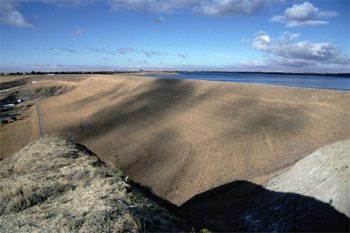Tiber Dam was part of an extensive project to mitigate flooding, generate electricity, irrigate the deserts of the Northern Plains, and ensure ample water to float commercial river traffic below Sioux City, Iowa. President Harry Truman officially initiated the Tiber Dam project in 1952.
Gigantic Fort Peck Dam near the Montana-North Dakota border, completed in 1940, was the first step in realizing the long-held dream of chaining down the unruly and unpredictable Missouri River.
In 1944 Congress approved the plan, and military demobilization at the close of World War II provided the work force to put the concept into action. The objective was to build six main-stem dams and reservoirs on the Missouri River, which would hold back spring runoff to mitigate flooding downstream, and release water in the summertime to insure navigability of the lower Missouri and the Mississippi, as well as for irrigation and electrical power generation.
Tiber Dam was a spinoff from the dryland reclamation movement represented by the Pick-Sloan plan, and in this case irrigation was the prime motivation. Preliminary plans developed by the Bureau of Reclamation around 1950 even included a proposal to import water into the Marias River Basin from the Waterton, Belly, and St. Mary Rivers, which are in the Hudson Bay drainage, but the International Joint Commission rejected that idea. Extensive supply canals and distribution systems were planned for the Lower Marias Unit, as well as two seasonal power generating plants.
Tiber Dam was completed in 1956, and since then has served chiefly as a means of flood control on the lower Marias; it bore the brunt of major floods in 1964 and 1975. Also, the reservoir regularly provides additional water to facilitate navigation on the lower Missouri. Some small individual irrigation diversions are functioning, but the original irrigation plan has not yet materialized, and the uplands are still drylands.
The water intake facility was built to provide water for the Anti-Ballistic Missile control center, 6 miles to the southwest of Tiber Dam. When construction of the ABM site was shut down following President Richard Nixon’s Strategic Arms Limitation Talks with the Soviet Union in 1971, the water system was turned over to the Tiber Water District to provide water for domestic and farmstead use to six counties. It cannot carry enough water to irrigate crops.
Experience the Lewis and Clark Trail
The Lewis and Clark Trail Experience—our sister site at lewisandclark.travel—connects the world to people and places on the Lewis and Clark Trail.
Discover More
- The Lewis and Clark Expedition: Day by Day by Gary E. Moulton (University of Nebraska Press, 2018). The story in prose, 14 May 1804–23 September 1806.
- The Lewis and Clark Journals: An American Epic of Discovery (abridged) by Gary E. Moulton (University of Nebraska Press, 2003). Selected journal excerpts, 14 May 1804–23 September 1806.
- The Lewis and Clark Journals. by Gary E. Moulton (University of Nebraska Press, 1983–2001). The complete story in 13 volumes.



